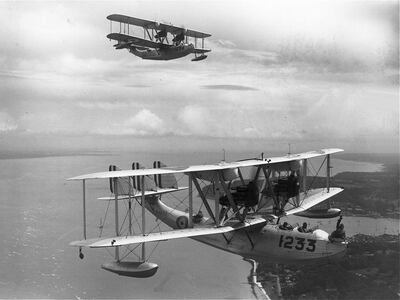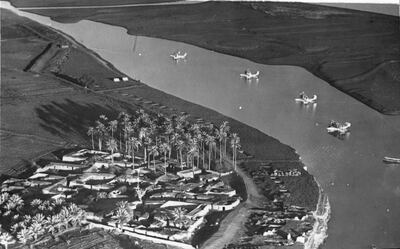In the past month, the UAE achieved two firsts for the Arab world with the launch of the Hope probe to Mars and the opening of the Barakah nuclear power station. Here, in the first of a new series, The National looks at more of the country’s firsts – events that changed our lives and helped make the Emirates what it is today.
We begin more than 90 years ago, when the people of Abu Dhabi watched in astonishment as the first aircraft came in to land.
It’s an iconic image. A huge propeller-driven passenger aircraft readied for take off at Sharjah’s Al Mahatta airport. Curious onlookers mingled with the passengers, all dwarfed by the massive machine.
The year was 1932 and the aircraft was a Handley Page HP42, one of four operated by Imperial Airways on the route between London and British India. Sharjah was a key overnight stop on the six day journey and the emirate had joined the new world of international air travel.
Though this was not the first aircraft to land at what is now the United Arab Emirates, but was then a British protectorate called the Trucial States.
To witness that moment, it is necessary to go back three years, to June 19, 1929 and to Abu Dhabi, where an astonished crowd gathered on the beach as something strange and wonderful approached from the skies.
But first, a short history of flight in the Middle East. Aircraft had been operating in the region for nearly 20 years before that historic landing in Abu Dhabi.
Without doubt, the first to take to the air was Charles Ritchie, who worked for the Anglo-Persian Oil Company at Abdan in present day Iran.
It was Ritchie’s job to inspect the oil pipeline for leaks, a tedious job that involved hours on horseback. Locals were hired to tighten the bolts on the pipes, but Ritchie suspected they were also loosening them to bring more work. A spot of airborne surveillance might do the trick.
It was 1911 and less than two years since the celebrated French aviator Louis Bleriot crossed the English Channel n his monoplane and only eight years after the Wright brothers made the first powered flight.
The saddle-sore Ritchie had a brainwave. He telegraphed London with the instruction to “send one Bleriot monoplane with instruction book.”
Several years later, the company newsletter The Naft (the Arabic word for oil) recorded what happened. The aircraft – requiring some assembly – was delivered in a packing case, but with the instruction book in French.
Ritchie spoke no French nor could he fly. Undeterred, he put the monoplane together as best he could and even distilled some aviation fuel.
He managed to take off, but had only flown a short distance when, "unfortunately, the aeroplane came rather close to the surface, so that on banking one of the wings caught a small hillock and, of course, immediately broke and the machine overturned,” the magazine reported.
Worried onlookers rushed to see if he was still alive, only to be instructed by the upside down Ritchie “Don’t touch anything, you chaps, take a photograph.”
It was his first and last flight, with the horse returned to active service. Ritchie survived until 1914, when he succumbed to smallpox.
Aircraft, though, were here to stay. They played an important part in the First World War campaign in the Middle East, which ended with the defeat of the Ottoman Empire and Britain taking control of present day Iraq and the Royal Air Force establishing several bases across the country.
The first planes had a military role that included reconnaissance, but also the terrifying power of machine guns and bombs from the air. For the British, they were seen as essential tools for keeping down rebellious tribes in its eastern empire.
“The Air Force can carry out, at slight risk and at minimum expense, punitive operations which might take days or even weeks of preparation,” one 1920s report noted.
“The capacity of the Air Force to deal a swift and unexpected blow must in time to compel the submission of the most recalcitrant tribes,” the author added with satisfaction.
The potential of aircraft in battle was not lost on local rulers. On a visit to Basra in 1916, Ibn Saud, the future ruler of Saudi Arabia, was shown “the latest machinery of warfare including aircraft in which he took an eager interest,” the official report observed. He went on to create the Hejaz Air Force in 1921.
Aircraft would also soon play an important role in oil exploration in the 1930s. American oilmen frequently overflew Abu Dhabi territory, especially around Al Ain, whose sovereignty was then claimed by the Saudis.
These incursions were challenged by Abu Dhabi and Britain, which by then was engaged in its own negotiations for oil rights with the Rulers of the Trucial States.
British prospectors travelled over land, causing some confusion among tribes who were familiar with aircraft overhead, but not cars.
With larger and more powerful aircraft, the 1930s also saw the first long distance passenger flights. For London, a key route would be to India, and eventually Australia.
Even the biggest planes of the time could not travel more than a few hundred miles and at speeds no faster than cars today. Frequent stops were needed, with Imperial Airways at first preferring the Iranian side of the Arabian Gulf, a route that had been followed by the Royal Air Force since 1918.
By 1927, the Iranian rulers had fallen out with London, fearing British influence might damage plans to extend their influence over Gulf waters. With Imperial Airlines now blocked, attention was turned to the southern route and the Trucial States.
Efforts now began in earnest to persuade Rulers to allow a British airbase on their territory, with agreements eventually signed by Sharjah and for a flying boat dock on Dubai Creek.
It was for this reason that an expedition was planned in the early summer of 1929.
The aircraft chosen was Supermarine Southhampton, a twin engine RAF flying boat with a crew of three, and part of 203 Squadron based at Basra, using the Shatt al Arab river for take off and landing.
After leaving Iraq on June 17, the aircraft made it to Bahrain in just under three hours “aided by a strong wind” noted Capt Charles Prior, the political agent who headed the expedition.
Poor visibility forced them to turn back over Qatar the next day, but the weather improved on the 19th “and it was now decided to make for Abu Dhabi, which we reached at 1pm after some 4½ hours flying.”
The Southampton touched down without incident close to the beach and motored to shore. The party were shown to Qasr Al Hosn “to a shaded spot at the side of the fort where a carpet had been laid.”
They were received by a young Sheikh Shakhbut bin Sultan, then 29, and Ruler of Abu Dhabi for barely a year.
“Shaikh (sic) Shakhbut arrived with several relatives and apologised for not having been ready earlier, but he had been asleep and not known of my visit,” Prior wrote in his typed report to London.
“He was friendly and expressed a desire to see the plane, and on our return (the aircraft stopped in Abu Dhabi twice that day) he rowed out to the plane, but only had time for a cursory glance.”
While this was going on, the rest of the Southampton’s crew were “fully occupied from preventing the greater part of Abu Dhabi from swarming over the machine. A boat carrying out some of his (Sheikh Shakhbut’s) relatives capsized, but all swam to shore.”
Their reception was “excellent”, Prior wrote, with requests “to fly around the town low on our departure so that all might have a good look at the machine.”
From Abu Dhabi, the aircraft would head towards Ras Al Khaimah, identified as another possible landing spot. “What impressed that local inhabitants most was that we proposed to get to Ras Al Khaimah in two hours,” Prior wrote.
Directed by Wing Commander Thomas Howe – later an Air Commodore – and with two pilots listed as Flight Lieutenant Gandy and Flying Officer Southey, the flying boat made it to RAK by 5pm, to be greeted by the “friendly” ruler in his majlis who put them up overnight.
Fuel had been left there in advance by the local agent, the Khan Bahadur, and after refilling its tanks, the Southampton flew home via to Umm Al Quwain.
Following the coast back to Abu Dhabi, the aircraft made final stops at Dalmah and Sir Bani Yas Islands, where they found a pearling boat, and offered a tin of fruit as a gift, receiving in return what was probably pressed dates, but described by the Englishmen as “billstickers paste.”
Another three hours and 40 minutes took them back to Bahrain, flying back to Basra on June 22, 1929. The expedition was judged a huge success. “The reception in Abu Dhabi was almost overwhelming” the final report concluded, “it being the first aeroplane to be seen there.”
In a typical August, around 2,000 aircraft take off and land at the UAE’s airports every day. More fly from airbases and the private airport at Al Bateen.
It makes the Gulf air routes some of the busiest in the world, and just 91 years after the crew of a Supermarine Southampton flying boat had the skies to themselves.




